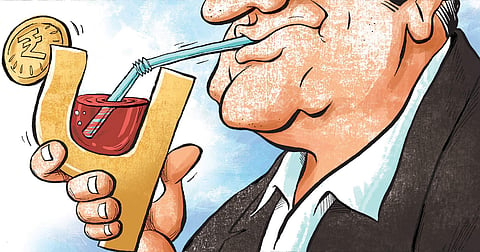

The belated discovery of a moon-size crater inside Punjab National Bank (PNB) opens up many fronts and leaves multiple questions unanswered. What’s more, the extent of damages is still evolving and could multiply as individual strands of the multi-layered transactions are extricated.
The overall outlook is also not that encouraging: the spaghetti bowl of interconnected transactions could result in a number of tangled legal disputes that could take some time to unravel. India’s largest commercial bank, the public sector State Bank of India, has just disclosed it has a $212 million exposure. In all, it feels like scam season once again!
The PNB episode seems to replicate all the steps observed in previous bank scams and carries echoes of similar collusions and cover-ups; what remains to be seen now is whether there is a flurry of post-scam reports from Reserve Bank of India (RBI) or Joint Parliament Committees, reminiscent of the Harshad Mehta scam.
To be sure, there will be much hand-wringing and chest-beating, new rounds of regulatory measures, additional layers of risk management processes and documentation followed through with an endless stream of circulars, guidelines and rules. And yet, all this will be secondary to human ingenuity which will always find a way through this thicket of paperwork and red tape.
The PNB incident highlights the problems of over-reliance on systems, processes and paperwork, indicating that if somehow some boxes are ticked, the problems will go away. While it might be too early to conclude that senior management was involved in the scam, it is clear that there were multiple failures at various levels. It might be informative to try and disentangle this skein of multiple threads.
First, and most baffling, how did the senior management members, the board directors and the auditors (external and internal) miss something of this size? Agreed that the liability was contingent but the liability was over `11,340 crore; that is over 25 per cent of the bank’s total capital. Any contingent liability of this size to one client or single entity should have set alarm bells ringing. At the least, it should have merited an examination of the account.
It also transpires from documents filed by PNB officials with CBI and with stock exchanges that Nirav Modi’s diamond firms—Diamonds R Us, Solar Exports, Stellar Diamonds—were caught out on 16 January 2018, when they went to seek buyer’s credit to make payments to overseas suppliers. Their calculations did not include the possibility of having to deal with a new set of bank managers.
The company management apparently bristled when the new manager asked them to provide 100 per cent cash margin for availing the facility because they did not have a sanctioned limit with the bank. In simple language, the new manager wanted Nirav Modi & Co to keep cash equivalent to the loan amount since they had not gone through the usual process of submitting to due diligence from the bank’s credit appraisal team.
This raises two questions. One: How did they manage for so long without obtaining a formal sanctioned facility with the bank? But more importantly, how did they manage to raise so many loans in foreign currency for so long without providing any security? Many institutions are known to provide a one-off facility based on business judgement and yield calculations. But Nirav Modi’s companies seemingly had unfettered access to the bank’s facilities. This does indicate some level of senior acquiescence.
Second, the ignorance is all the more appalling because Nirav Modi used PNB’s instruments to construct a web of multi-layered liabilities. This again could not have been possible without somebody up and down the chain noticing it. The notion that the PNB officers colluding with Nirav Modi kept the deals off the books also seems difficult to swallow since the counter-party banks on which the Letters of Undertaking (LoUs) were raised (Allahabad Bank or Axis Bank in Hong Kong) would have sent multiple deal stubs back to various parts of PNB’s risk management matrix—front, middle or back offices—for settlement and reconciliation. Even if we discount the possibility of complicity, it is a colossal systemic failure, one that has ripple effects across the industry.
In its letter to the stock exchanges, PNB claims: “The bank liability is contingent only. The liability shall be decided based on the law of land.” In other words, the liability is not known till there is legal clarity on who owes how much to whom. This seems to indicate that PNB senses a long-drawn legal battle ahead. But a cursory look at PNB’s website seems to indicate it’s business as usual—it is difficult to find PNB’s own press releases, the MD’s message to assuage investors and customers, or even the reports filed with stock exchanges. It is perhaps this lack of communication within the institution that kept the scam going undetected for so long.
But when all is done and dusted, two crucial questions remain unanswered. One, how all those accused of money laundering—Vijay Mallya, Nirav Modi, arms dealer Sanjay Bhandari—are able to leave the country just before a first information report is filed, or the enforcement directorate carries out raids on their homes and offices? Second, and this has national security implications: if Nirav Modi was not accompanying PM Narendra Modi to Davos as part of his official delegation as the government said, how did he photobomb a group portrait? He is standing an arm’s length away from Modi; is the PM’s security so lax that anybody hanging around in the vicinity can be allowed to stand in an official group photograph with him?
Rajrishi Singhal
Independent consultant and former business journalist
Email: rajrishi.singhal@gmail. com